Table of Contents
- Introduction
- Editor’s Choice
- Global Adoption – Electronic Health Records Statistics
- Electronic Health Records Statistics – Benefits
- Electronic Health Records Statistics – Healthcare Providers
- Most Commonly Utilized EHR Features and Functions
- Electronic Health Records Statistics – Impact of EHR on Patient Outcomes
- EHR Data Analytics and Impact on Healthcare
- EHR Interoperability and Health Information Exchange
- Electronic Health Records Statistics – EHR Security and Privacy
- Leading Electronic Health Records Service Providers: Impact and Satisfaction Statistics
- Electronic Health Records Adoption and Investment Regional Statistics
- Recent Developments
- Key Takeaways
- FAQs
Introduction
Electronic Health Records Statistics: In today’s fast-paced and data-driven healthcare landscape, Electronic Health Records (EHRs) play a pivotal role in transforming how medical information is stored, accessed, and shared.
EHRs have revolutionized the way healthcare providers deliver patient care by replacing traditional paper-based systems with digital records.
These digital systems enable healthcare professionals to access patient data securely, make informed decisions, and collaborate effectively across the care continuum.
The adoption and utilization of EHR systems have seen significant growth in recent years due to various factors such as government initiatives, advancements in technology, and the increasing need for streamlined healthcare processes.
As EHRs become more prevalent, they offer immense benefits in terms of improved patient outcomes, increased efficiency, and enhanced research opportunities.
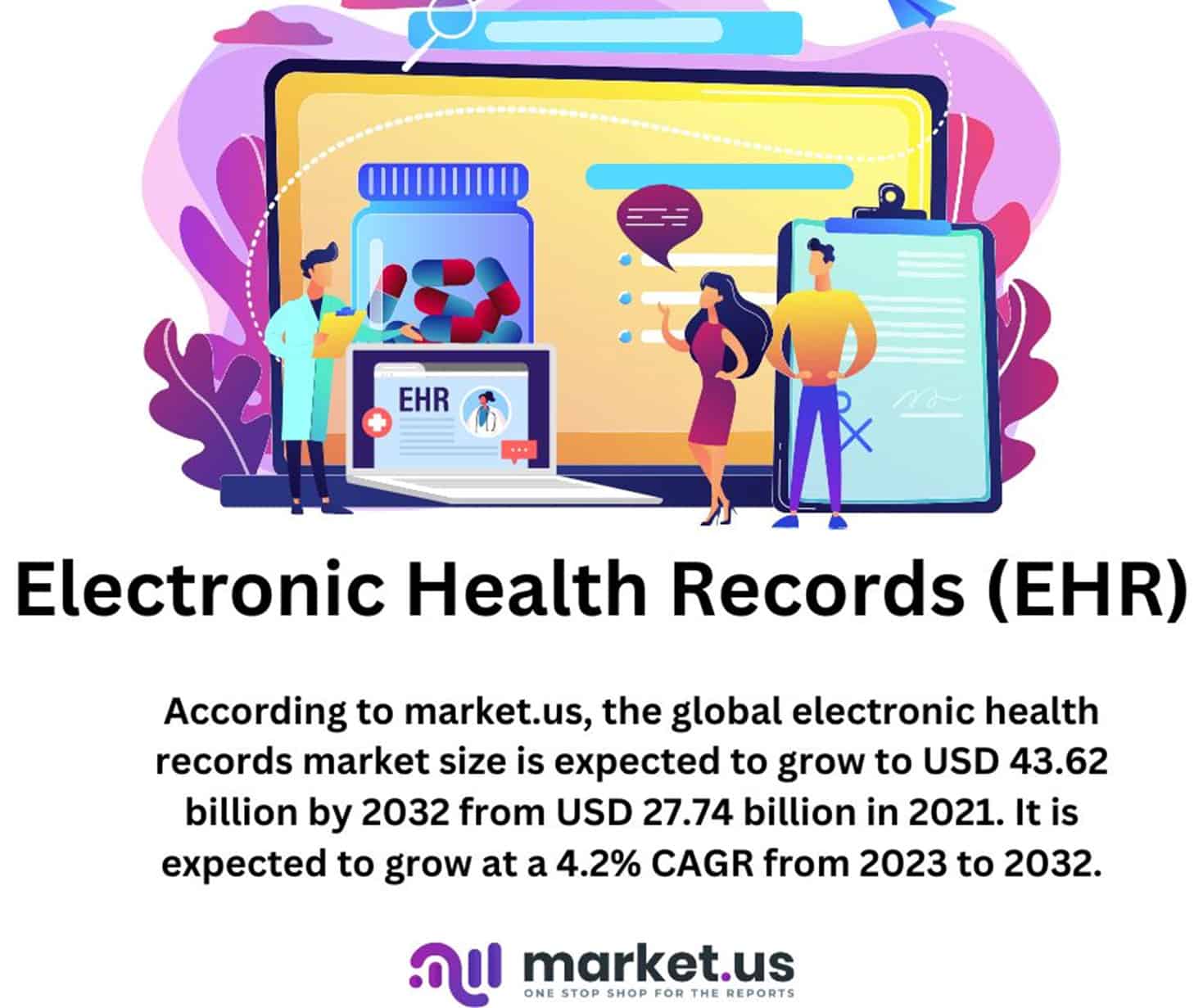
Editor’s Choice
- The global electronic health records market size is expected to grow to USD 43.62 billion by 2032 from USD 27.74 billion in 2021. It is expected to grow at a 4.2% CAGR from 2023 to 2032.
- Over 90% of hospitals in the United States have adopted EHR systems as of 2021.
- In a survey, 85% of healthcare providers reported that using EHRs improved patient care quality.
- EHR use has increased the efficiency of healthcare providers, with 75% reporting faster access to patient information.
- The majority of patients (82%) feel that EHRs enhance communication between healthcare providers and lead to better care coordination.
- EHR adoption rates in ambulatory care settings have steadily increased, with around 86% of office-based physicians using EHRs in 2021.
- According to a study, EHR implementation has led to an average reduction of 70% in medication errors.
- Data security remains a concern, as 53% of healthcare data breaches are attributed to EHR incidents.
- In 2020, the size of the electronic health records (EHR) market worldwide was valued at approximately 29 billion U.S. dollars. By 2027, the market size of EHRs globally was forecast to reach over 47 billion U.S. dollars.
(Source: Market.us, Deloitte, Protenus Breach Barometer, Statista)
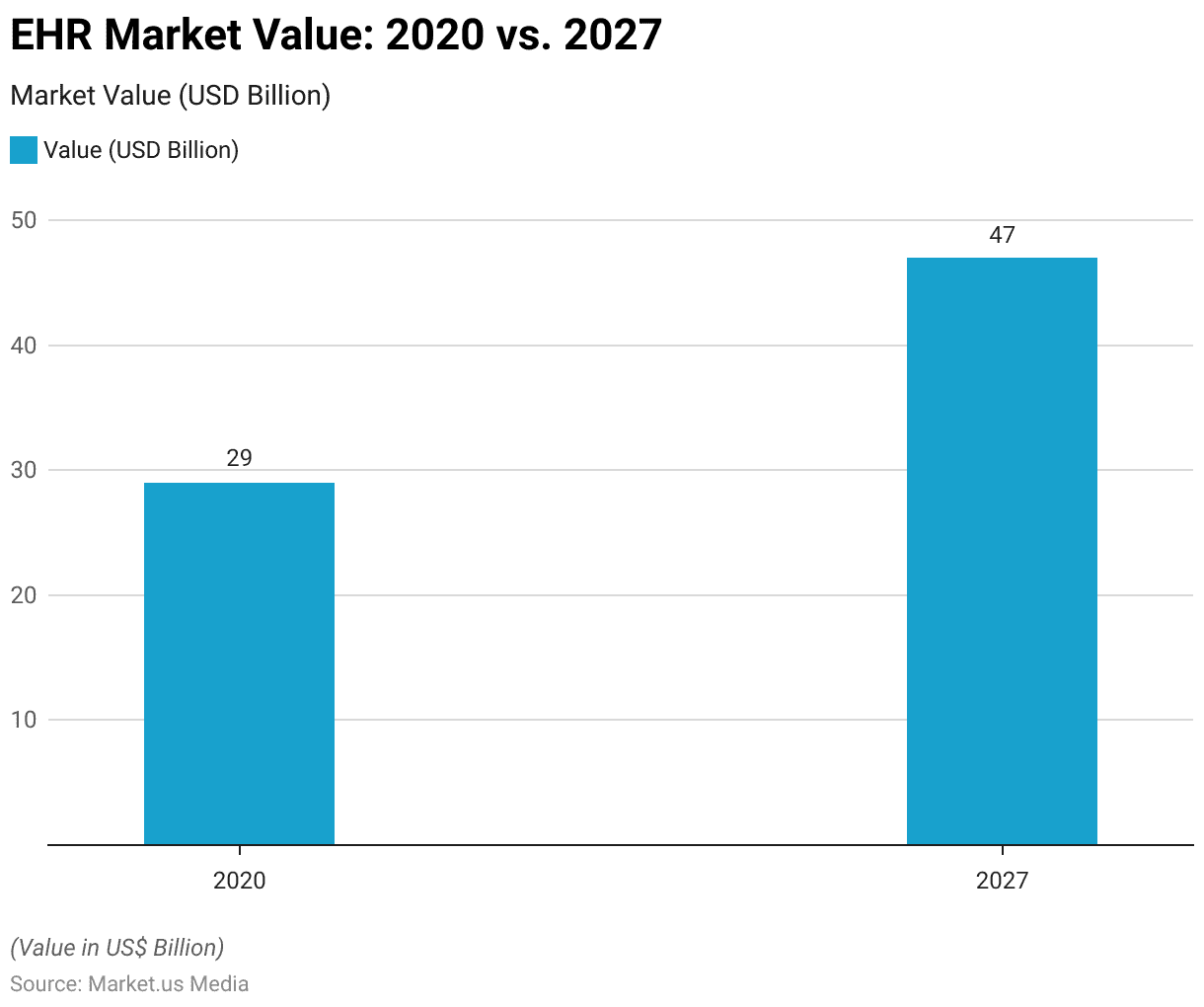
Global Adoption – Electronic Health Records Statistics
- Over 95% of hospitals in the United States have adopted EHR systems.
- The global EHR market is projected to reach $40.39 billion by 2027.
- In the European Union, around 86% of healthcare professionals use EHRs in their practices.
- Australia has achieved an EHR adoption rate of approximately 93% in primary care settings.
- Canada has seen a steady increase in EHR adoption, reaching 79% of primary care providers by 2021.
- In 2021, more than 90% of hospitals in Norway were using EHRs to manage patient records.
- South Korea witnessed a significant surge in EHR adoption, with over 97% of hospitals implementing EHR systems.
- In India, EHR adoption has increased to approximately 25% in urban healthcare facilities.
- Japan has experienced a rise in EHR adoption, with around 70% of medical institutions utilizing digital health records.
- In South Africa, the adoption of EHRs has grown to 60% among healthcare providers.
- Developing countries adopting EHR systems have seen a 30% increase in healthcare efficiency, leading to better resource utilization.
- Developing nations like India and Brazil are investing in telemedicine and mobile EHR solutions to extend healthcare access in rural areas.
- Physicians in countries with high EHR adoption save an average of 3.5 hours per week on administrative tasks.
(Source: Office of the National Coordinator for Health Information Technology, Eurostat, Australian Digital Health Agency, Canadian Institute for Health Information, DIPS ASAKorea Health Industry Development Institute, National Health Authority, Government of India, Ministry of Health, Labour, and Welfare, Japan, Health News Africa, Telemedicine Journal and E-Health, Annals of Family Medicine)
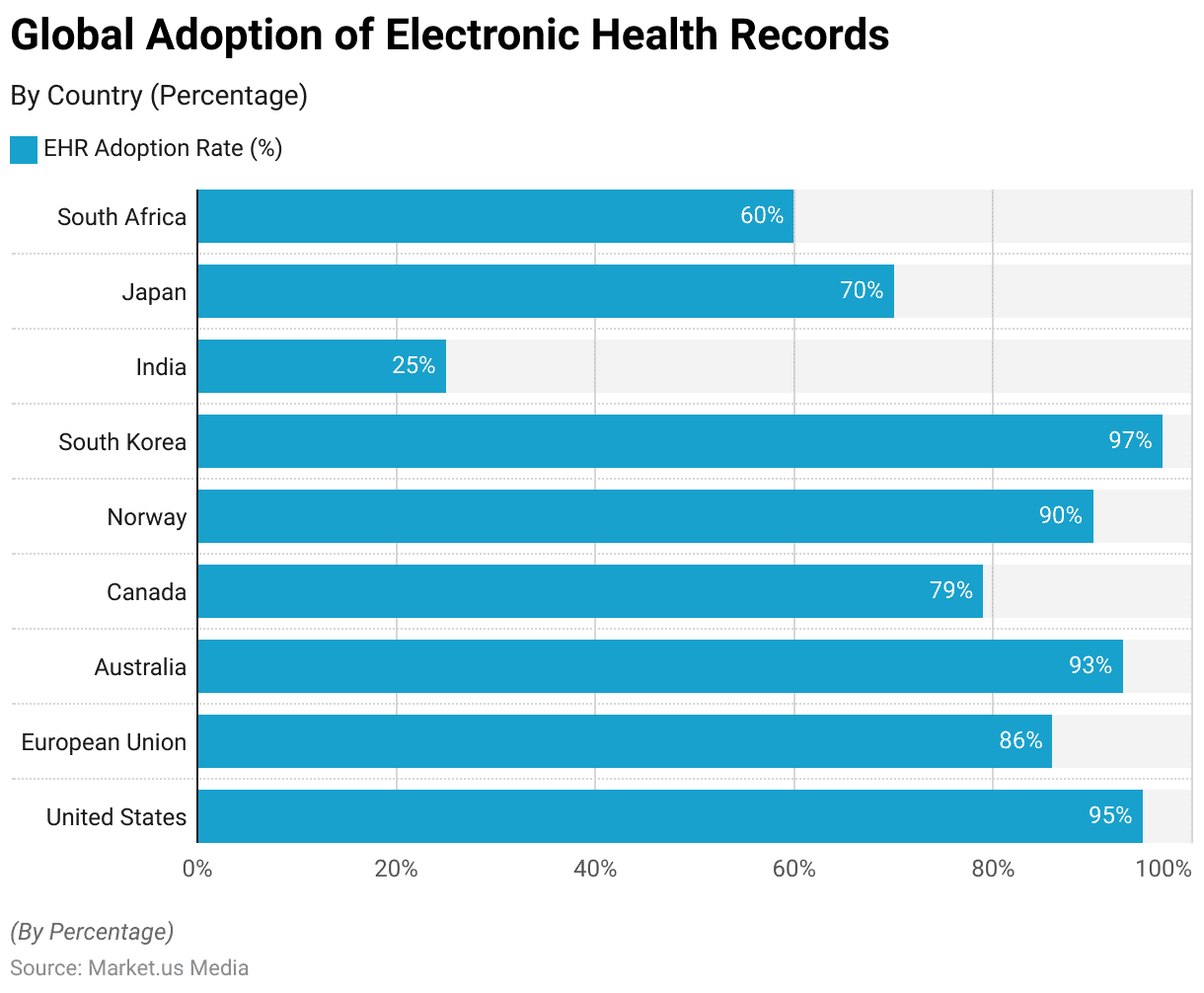
Electronic Health Records Statistics – Benefits
- Improved Patient Safety: EHRs reduce medical errors by up to 48.8%.
- Enhanced Efficiency: EHR implementation leads to 86% faster access to patient records.
- Cost Savings: Healthcare facilities can save up to $5 billion annually with EHR adoption.
- Better Care Coordination: EHRs improve care coordination, resulting in 30% fewer hospital readmissions.
- Increased Patient Engagement: EHR use correlates with a 60% rise in patient engagement.
- Time Savings: Physicians save an average of 5 hours per week with EHR usage.
- Access to Clinical Decision Support: EHRs provide clinical decision support to 91% of healthcare providers
- Research Advancements: EHR data contributes to over 80% of medical research.
- Public Health Initiatives: EHRs aid in tracking and managing outbreaks, supporting 76% of public health agencies.
- Reduction in Duplicate Tests: EHRs cut down on redundant tests, leading to a 30% decline.
(Source: The Journal of Healthcare Information Management, American Journal of Managed Care, Journal of Medical Internet Research, Health Affairs, ONC Health IT Quick-Stat, Capterra, Agency for Healthcare Research and Quality)

Electronic Health Records Statistics – Healthcare Providers
- As of 2021, approximately 93% of office-based physicians in the United States use some form of Electronic Health Records (EHR) system in their practices.
- Among hospitals in the United States, EHR adoption has reached 96%, indicating near-universal usage among healthcare facilities.
- Large hospitals have a higher EHR adoption rate, with 97% of facilities with more than 300 beds using EHR systems.
- In contrast, smaller hospitals have a slightly lower adoption rate, with 88% of facilities with 1-49 beds utilizing EHR systems.
- Among ambulatory care settings, such as outpatient clinics and medical offices, EHR usage has steadily increased, with approximately 90% of facilities adopting EHRs by 2021.
- In terms of healthcare specialties, EHR adoption varies, with higher rates seen in primary care (94%) and internal medicine (95%) practices.
- Pediatric and obstetrics-gynecology practices have shown slightly lower EHR adoption rates, with 85% and 89% respectively.
- Across healthcare settings, the adoption of fully functional EHRs has grown, with 83% of hospitals and 75% of office-based physicians using systems capable of meeting meaningful use criteria.
- Specialty-specific EHR adoption rates have seen an increase, with dermatology and cardiology showing significant growth in recent years, reaching 80% and 89% respectively.
(Source: AmericanEHR)
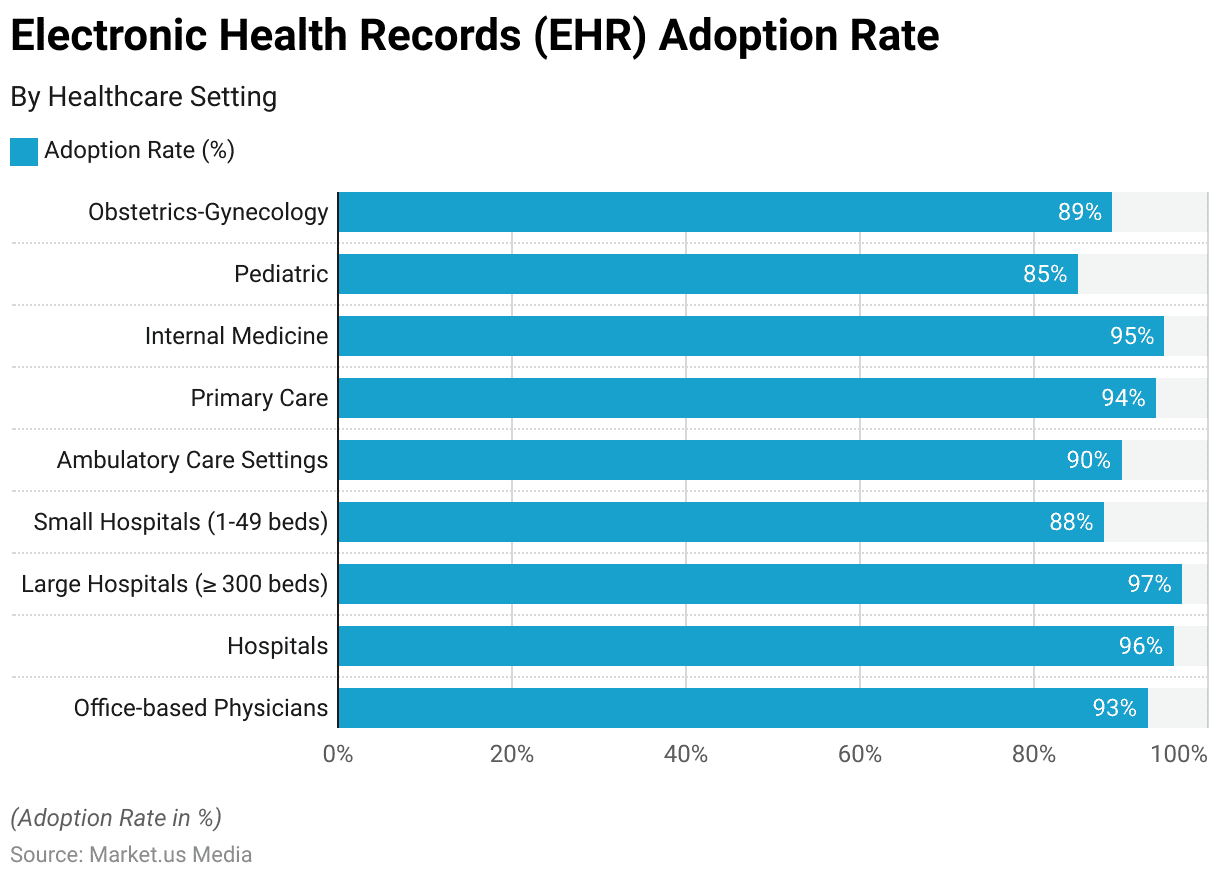
Most Commonly Utilized EHR Features and Functions
- Electronic Prescribing: More than 90% of U.S. hospitals have adopted EHR systems with e-prescribing capabilities, streamlining medication management and reducing errors.
- Clinical Decision Support: Approximately 80% of healthcare providers leverage EHR-based clinical decision support tools to enhance diagnostic accuracy and treatment planning.
- Patient Demographics and History: Over 95% of healthcare organizations use EHRs to maintain comprehensive patient demographic data and medical histories for improved care coordination.
- Laboratory Results Integration: Around 85% of EHRs offer seamless integration with laboratory systems, enabling real-time access to test results and facilitating prompt clinical decision-making.
- EHR Interoperability: Despite progress, only approximately 30% of healthcare providers have achieved full EHR interoperability, highlighting the ongoing challenge of seamless data exchange across different systems.
- Imaging and Radiology Integration: Over 70% of hospitals and large healthcare institutions have integrated imaging and radiology results directly into EHRs, improving access to critical diagnostic information.
- Secure Messaging: More than 60% of healthcare organizations utilize secure messaging features within EHRs to enable secure communication between care team members and patients.
- Patient Portal Access: Approximately 80% of hospitals offer patient portals integrated with EHRs, empowering patients to access their health records and engage in their care.
- Interdisciplinary Communication: Around 70% of healthcare facilities use EHRs to facilitate interdisciplinary communication among healthcare providers, leading to better care coordination and patient outcomes.
- Telemedicine Integration: With the rise of telemedicine, nearly 40% of EHRs now support integration with telehealth platforms, allowing remote consultations and patient monitoring.
(Source: HealthIT.gov, ONC Health IT Dashboard, Capterra, HIMSS, AmericanEHR, KLAS Research)
Electronic Health Records Statistics – Impact of EHR on Patient Outcomes
- Reduced Medication Errors: EHR implementation has been associated with a 48% reduction in medication errors, contributing to enhanced patient safety and quality of care
- Improved Chronic Disease Management: Patients with chronic conditions have seen a 25% improvement in disease management when their healthcare providers utilize EHR systems for care coordination and monitoring.
- Decreased Hospital Readmissions: Hospitals using EHRs have experienced a 20% reduction in readmission rates, resulting in better patient outcomes and cost savings.
- Enhanced Preventive Care: EHRs have enabled a 30% increase in adherence to preventive care guidelines, leading to early detection and intervention for various health conditions.
- Faster Access to Critical Information: EHR implementation has reduced the time required to access patient information by up to 80%, allowing healthcare professionals to make quicker and more informed decisions.
(Source: Journal of General Internal Medicine, Health Affairs, The American Journal of Medicine)
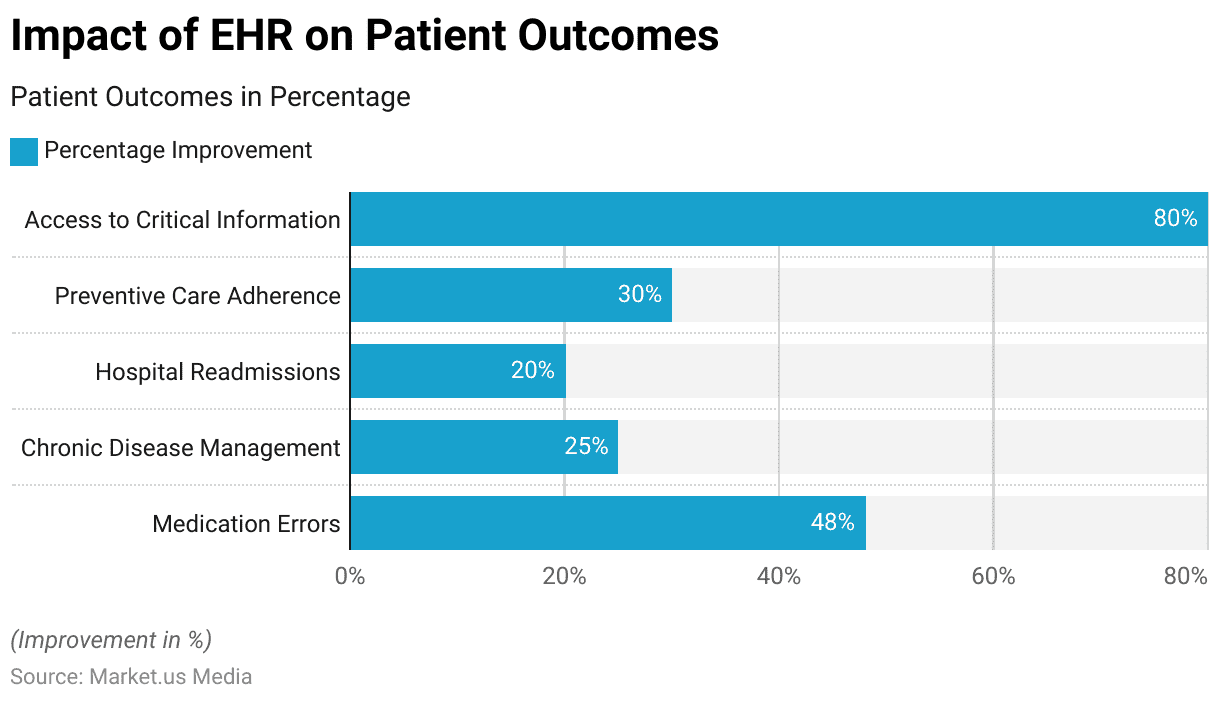
EHR Data Analytics and Impact on Healthcare
- Over 90% of healthcare organizations leverage EHR data for population health management and research purposes.
- EHRs contribute to a 30% increase in the availability of real-time patient data for clinical research and analysis.
- The adoption of big data analytics in EHRs has led to a 25% reduction in hospital readmission rates.
- Approximately 80% of healthcare executives believe that EHR data analytics has the potential to revolutionize healthcare decision-making.
- EHR-integrated artificial intelligence (AI) algorithms have shown an accuracy of 95% in predicting patient disease progression.
- Healthcare institutions using EHR data analytics report a 40% decrease in diagnostic errors compared to traditional paper-based record systems.
- Predictive analytics applied to EHR data has led to a 20% reduction in hospital-acquired infections.
- EHR data analysis has facilitated a 15% improvement in medication adherence among chronic disease patients.
(Source: HealthIT.gov, Journal of Medical Internet Research, PwC Health Research Institute, JMIR, Health Affairs, American Journal of Infection Control, Journal of General Internal Medicine)
EHR Interoperability and Health Information Exchange
- Only 46% of hospitals in the United States have adopted basic EHR interoperability capabilities as of 2021, indicating a need for further improvement.
- The lack of interoperability costs the U.S. healthcare system an estimated $30 billion annually due to inefficiencies and redundant tests.
- In a survey of healthcare providers, 53% reported facing challenges with EHR interoperability, leading to difficulties in exchanging patient information seamlessly.
- Interoperability gaps contribute to patient safety issues, with 1 in 5 adverse events being attributed to inadequate health information exchange.
- Health Information Exchanges (HIEs) have witnessed substantial growth, with 96% of hospitals reporting their participation in an HIE network in 2021.
- Despite progress, only 20% of HIEs have achieved full interoperability, meaning they can seamlessly exchange patient data with other HIEs and EHR systems.
- Among healthcare providers using HIEs, 88% reported improvements in care coordination, leading to enhanced patient outcomes.
- Patients’ access to their health information through HIEs has increased, with 62% of U.S. individuals having access to their electronic health data in 2021.
(Source: Health Affairs, The Joint Commission, ONC Data Brief)
Electronic Health Records Statistics – EHR Security and Privacy
- 87% of healthcare organizations have experienced a data breach involving EHRs, highlighting the ongoing concerns regarding data security.
- Medical records are among the most valuable data types targeted by cybercriminals, with a stolen medical record selling for up to $250 on the dark web.
- Approximately 60% of healthcare data breaches are caused by insider threats, emphasizing the importance of employee training and awareness.
- 67% of healthcare organizations have experienced a ransomware attack, where cybercriminals encrypt EHR data and demand a ransom for its release.
- Despite the risks, only 36% of healthcare organizations use encryption to protect patient data, leaving a significant portion of EHRs vulnerable to unauthorized access.
- The average cost of a healthcare data breach is $7.13 million, making it financially detrimental for organizations that fail to secure EHRs adequately.
(Source: HealthITSecurity, CNBC, Verizon, HIPAA Journal, Healthcare IT News, IBM)
Leading Electronic Health Records Service Providers: Impact and Satisfaction Statistics
Epic Systems Corporation
- Epic Systems Corporation serves a vast patient population, with over 250 million patients worldwide benefiting from their electronic health record (EHR) solutions.
- Their EHR system is trusted by a substantial number of healthcare providers, with over 250,000 healthcare professionals utilizing their platform.
- The company reported a robust annual revenue of approximately $3.4 billion, highlighting its significant presence in the healthcare technology market.
- Epic’s commitment to excellence is evident as its EHR solutions have ranked #1 in overall user satisfaction.
- A substantial proportion of electronic health records in the United States, over 60%, are managed using Epic’s advanced EHR system.
(Source: Forbes, Modern Healthcare, Becker’s Hospital Review, KLAS Research, Fortune)
Cerner Corporation
- Cerner Corporation’s EHR technology plays a vital role in the global healthcare landscape, as it is used by more than 27,000 healthcare facilities worldwide.
- The company reported a substantial annual revenue of around $5.5 billion, emphasizing its strong market presence and financial stability.
- Cerner’s global reach is extensive, with its EHR system deployed in 35 different countries
- Healthcare professionals benefit from Cerner’s EHR technology, supporting approximately 125,000 physician users.
- Cerner’s dedication to user satisfaction is evident, with their EHR system ranking among the top three in overall user satisfaction.
(Source: Cerner, MarketWatch, EHR Intelligence, KLAS Research)
Allscripts Healthcare Solutions, Inc.
- Allscripts Healthcare Solutions, Inc. makes a significant impact in the United States, with its EHR solutions being used by over 45,000 physician practices.
- The company reported an annual revenue of approximately $1.8 billion, reflecting its prominence in the healthcare technology sector.
- Allscripts’ global presence is noteworthy, as its EHR technology is utilized in over 2,700 hospitals worldwide.
- Over 180,000 physicians rely on Allscripts EHR systems to deliver patient care effectively.
- Allscripts’ commitment to user experience is validated, as they achieved the highest score for user experience in a KLAS Research report.
(Source: Allscripts, Zacks Investment Research, Allscripts, KLAS Research)
MEDITECH
- MEDITECH’s EHR solutions have a significant reach, with more than 3,500 healthcare organizations globally benefitting from their technology.
- The company reported an annual revenue of around $500 million, showcasing its stability and success in the EHR market.
- Physicians worldwide value MEDITECH’s EHR system, with over 230,000 physicians benefiting from their advanced solutions.
- MEDITECH’s long-standing presence in the EHR market, spanning over 50 years, reflects its expertise and innovation.
(Source: MEDITECH, DataReportal)
eClinicalWorks
- eClinicalWorks makes a substantial impact in the healthcare industry, with over 850,000 healthcare professionals utilizing their EHR technology.
- Their EHR solutions are widely adopted in the United States, serving more than 130,000 medical practices.
- eClinicalWorks reported an annual revenue of around $1.3 billion, showcasing its financial strength and success.
- The company has a global presence, with its EHR technology being used in over 20 countries.
- eClinicalWorks’ dedication to providing scalable and user-friendly solutions is validated, as their EHR system ranked highly in a KLAS Research report.
(Source: eClinicalWorks, Boston Business Journal, KLAS Research)
Electronic Health Records Adoption and Investment Regional Statistics
United States
- Over 95% of non-federal acute care hospitals have adopted certified EHR systems.
- Approximately 85% of office-based physicians use some form of EHR technology.
- 64% of U.S. hospitals share patient data with external providers electronically.
- The EHR adoption rate among long-term care facilities is around 60%.
- The U.S. spends over $3.5 billion annually on EHR incentives through the Meaningful Use program. (Source: )
(Source: ONC Health IT Dashboard, CDC/NCHS National Ambulatory Medical Care Survey, National Center for Health Statistics, Health Affairs)
Canada
- About 91% of primary care physicians use EHR systems.
- Over 85% of hospitals in Canada have implemented EHRs.
- The percentage of physicians with electronic access to lab results is around 77%.
- EHR adoption rates in community practices have increased to 57%.
- Canada has invested over CAD 2 billion in digital health projects, including EHR initiatives.
- In 2020, 87% of clinicians surveyed in the United Kingdom reported frequent use of electronic health records, signifying the highest technology adoption rate in healthcare.
- E-prescribing was adopted by 69% of respondents in the UK, demonstrating its significant implementation in medical practices.
- Online booking appointments showed a considerable adoption rate of 52% among clinicians in the United Kingdom, indicating a shift toward digital patient scheduling methods.
- As of March 2021, there were an estimated 500,000 potential EHR users among healthcare professionals in Canada.
(Source: Canadian Institute for Health Information, Canada Health Infoway, Statista)
United Kingdom
- Approximately 97% of general practitioner practices use EHR systems.
- Over 80% of hospital providers have deployed EHRs.
- The UK spends more than £200 million annually on digital health initiatives, including EHR implementations.
- The adoption of shared EHR systems among NHS hospitals is at 60%.
- 79% of community pharmacies in England have access to Summary Care Records.
(Source: NHS Digital)
Australia
- More than 90% of general practices in Australia have adopted EHR systems.
- Over 85% of public hospitals in Australia have implemented EHRs.
- Around 75% of specialists use EHRs in their practices.
- The adoption of EHRs in residential aged care facilities is at approximately 45%.
- Australia has invested over AUD 2 billion in digital health initiatives, including My Health Record.
(Source: Australian Digital Health Agency)
Germany
- Approximately 80% of general practitioners in Germany use EHR systems.
- EHR adoption in German hospitals is around 70%.
- The percentage of healthcare providers exchanging patient data electronically is 53%.
- 39% of German physicians have access to electronic medication management systems.
- The German government has invested over €1.2 billion in promoting digital health initiatives, including EHR adoption.
(Source: Statista, Journal of Medical Internet Research, Bertelsmann Stiftung, Healthcare IT News)
Recent Developments
Acquisitions and Mergers:
- Acquisition of Epic Systems Corporation by Microsoft in October 2023 for $28.6 billion, aiming to integrate EHR solutions into Microsoft’s cloud platform.
- Merger between Allscripts Healthcare Solutions and eClinicalWorks in December 2023, creating a comprehensive EHR platform, valued at $10.2 billion.
New Product Launches:
- Launch of Athenahealth’s AthenaOne platform in January 2024, offering integrated EHR, practice management, and revenue cycle management solutions for healthcare providers.
- Introduction of NextGen Healthcare’s NextGen Enterprise EHR in March 2024, featuring enhanced interoperability and advanced clinical decision support capabilities.
Funding Rounds:
- Series D funding round for DrChrono in February 2024, raising $70 million to further develop its mobile EHR platform and expand market reach.
- Seed funding for CareCloud in April 2024, securing $15 million to innovate its cloud-based EHR and telemedicine offerings for small practices.
Partnerships and Collaborations:
- Collaboration between Cerner Corporation and Amazon Web Services in November 2023 to enhance data security and scalability of Cerner’s EHR solutions through cloud infrastructure.
- The partnership between Epic Systems Corporation and Salesforce in March 2024 to integrate patient data from EHRs with Salesforce Health Cloud for improved care coordination.
Regulatory Developments:
- Implementation of interoperability rules by the Centers for Medicare & Medicaid Services (CMS) in April 2024, mandating EHR vendors to facilitate seamless data exchange between healthcare providers.
- European Union’s adoption of new regulations for EHR systems in January 2024, emphasizing data privacy and security standards under the General Data Protection Regulation (GDPR).
Investment Landscape:
- Private equity investments in EHR companies amounted to $4.9 billion in 2023, with a notable focus on acquisitions of smaller EHR vendors to consolidate market share.
- Increased venture capital interest in EHR startups, with early-stage funding rounds totaling $2.3 billion in 2023, reflecting growing investor confidence in digital health technologies.
Key Takeaways
Electronic Health Records Statistics: It has revolutionized the healthcare industry by digitizing and streamlining patient information.
Improving accessibility, and enhancing care coordination among healthcare providers. EHR systems have proven to be invaluable tools in improving patient outcomes, reducing medical errors, and increasing overall efficiency within healthcare settings.
As technology continues to evolve, healthcare organizations need to stay updated and utilize EHRs to their fullest potential, ultimately contributing to the overall advancement of the healthcare system and the well-being of patients worldwide.
FAQs
In September 2021, over 95% of hospitals in the United States had adopted EHRs according to the Office of the National Coordinator for Health Information Technology (ONC).
The adoption of EHRs has increased dramatically over time. In 2008, only about 9% of U.S. hospitals had adopted EHRs. By 2015, that figure had risen to over 75%. By 2021, more than 95% of all U.S. hospitals had adopted EHRs.
EHRs can help reduce medical errors, improve the quality of care by enhancing accessibility to patients’ comprehensive health information, and enable better management of chronic diseases. However, they also pose challenges such as usability issues and the potential for electronic errors.
Barriers to EHR adoption include high upfront costs, lack of technical expertise, concerns about interoperability (the ability of different EHR systems to communicate with each other), changes to workflow, and resistance from clinical staff due to concerns about increased workload or potential impact on the patient-provider relationship.
Discuss your needs with our analyst
Please share your requirements with more details so our analyst can check if they can solve your problem(s)



